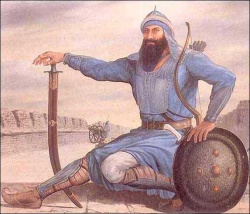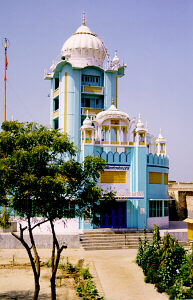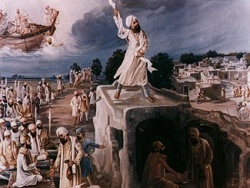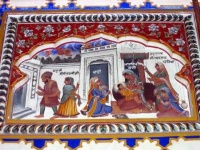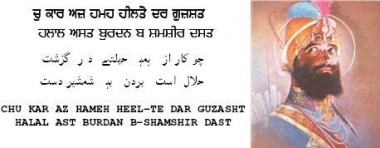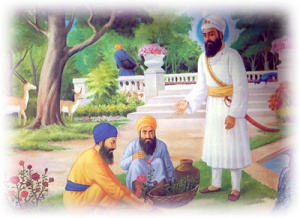SikhiWiki:Proposed Featured Articles: Difference between revisions
Hari singh (talk | contribs) (→PMA 4) |
Hari singh (talk | contribs) (→PMA 5) |
||
| Line 69: | Line 69: | ||
[[Makhan Shah Labana]].......by [[user:paapi]] | [[Makhan Shah Labana]].......by [[user:paapi]] | ||
{{aowh|Makhan Shah Labana}} | {{aowh|[[Makhan Shah Labana]]}} | ||
[[Image:Makhanlubana.jpg|thumb|250px|left|{{cs|Makhan Shah Labana}}]] | [[Image:Makhanlubana.jpg|thumb|250px|left|{{cs|Makhan Shah Labana}}]] | ||
Revision as of 10:26, 16 July 2007
This is the place to recommend articles for the Mainpage. Just enter the link to the article page and someone will create a summary introduction which will be in a queue to appear on the Mainpage soon.
PFA 1
Sugessted by User:Hari singh - Done, see Template:AOW109
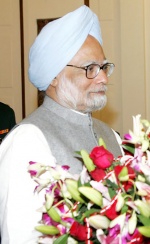
Most people in the west who wear the turban are Sikhs. All Sikhs, but particularly male Singhs are required to don the Dastaar due to the pronouncement in 1699 by the tenth Sikh master Guru Gobind Singh. Dastaar, is the native Punjabi term used to refer to this headdress. Even 300 years on, it is in compliance to the Hukam (or order) of this supreme Sikh leader that all Sikhs today wear the dastaar. It is in honour and obedience to this one person! The Sikh prime minister of India, Dr Manmohan Singh, displays his sky blue trademark turban out of respect for the Sikh Guru; the famous record breaking, 95-year-old marathon runner, Fauja Singh proudly wears his dastaar in honour of the tenth Sikh teacher; Bhagat Puran Singh the humble humanist and philanthropist used to don a simple turban in respect of the Sikh master. Why do the Sikhs go to all this trouble so many years after the diktat?
The dastaar comes in many different colours and styles and to the keen eye, each turban is different. Some are simple but regal; others may be bright and sporty; yet others may be stylish and extravagant – each one has it own special and unique statement. Every morning, most Sikh man and many Sikh women, spend some 5 to 20 minutes to comb their long hair and then carefully handicraft the link to their Gurus – a daily reminder of their heritage and its responsibilities. .....More
Proposed Male Article
PMA 1
Suggested by user:paapi in June 2007. Done, see Template:AOW111
Baba Banda Singh Bahadur (1670-1716) (Lachhman Dev alias Madho dass Bairagi) , of Jammu region, is revered as one of greatest warriors as well as one of its most hallowed martyrs of the Khalsa Army who were fighting against the Cruel Muslim rule and their tyranny. His confrontation with the Muslim administration in Northern India, though brief, was strong enough to shake its foundations. The agrarian uprising that he led in the Punjab was the foundation on which the Dal Khalsa, the Sikh Misls and Maharaja Ranjit Singh built the edifice which finally culminated with Ranjit Singh capturing Lahore in 1799 and establishing the Sikh Kingdom of the Punjab.
Banda was born in a Minhas Rajput family on October 16, 1670 at Rajouri in the Jammu region of Jammu and Kashmir. He was named Lachman Dev. Wrestling, horseback riding, and hunting were his major hobbies. As a young man, he shot a doe and was shocked to watch the mother and her aborted fawn writhing in pain and dying. After this gloomy scene, he had a change of heart. He left his home and became a disciple of a Bairagi Sadhu, Janaki Das, who gave him the name, Madho Das. In the company of the Sadhus he travelled through Northern India and finally arrived at Nanded (in present-day Maharashtra), situated on the bank of the river Godavari, where he built a hut to meditate upon God. .....More
PMA 2
Suggested by user:paapi. Done, see Template:AOW110
Baba Gurditta, was the eldest son of the sixth Sikh Guru, Guru Hargobind; was born in 1613 at Daroli Bhai, District Firozpur. He was also an elder brother of Shri Guru Tegh Bahadur. He married to Mata Nihal Kaur. He was father of Guru Har Rai and Dhir Mall. Guru Hargobind received the shocking news of the death of his eldest son Baba Gurditta who passed away at age 24, in 1638. He had two sons, the eldest was called Har Rai.
Baba Gurdita, the son of Guru Hargobind along with Bhai Bidhi Chand commanded the defensive action when the Sikhs were besieged in Kartarpur. Guru Sahib himself took part in this action. Painde Khan attacked the Guru with his sword but the Guru, shielding himself, paid him back in the same coin after accepting his challenge. The Guru is said to have wept to see him breathing his last. Baba Gurdita took the defensive when he was attacked in the hand fight by one Asman Khan, his playmate in childhood. The Baba, however, mourned the death of his classmate with the remarks that to kill him was not considered a measure of success, rather it was a disappointment to have been forced by circumstances to kill a friend. Generals Kutab Khan and Kale Khan, both were slain in hand to hand fighting with Guru Hargobind .....More
PMA 3
Suggestion by user:paapi in June 2007. Done, see Template:AOW107
Nawab Kapur Singh Virk (1697-1753) is considered one of the most revered, pivotal and legendary figures in Sikh history, under whose leadership, decisions and courage,the tiny Sikh community traversed through some the darkest periods of its history. The founding father of the Sikh Confederacy & Sikh Empire, he was also the founder of the Dal Khalsa. Alongside Banda Bahadur, he laid the foundations of the Sikh Empire. Today, he is regarded by Sikhs to be of equal importance to Banda Singh Bahadur.
The period, starting from the massacre in Delhi of Banda in 1716 and his seven hundred followers, was followed by severe action against the Sikhs, including massacres of young men, women and children. However, every fresh adversity only stimulated their will to survive, planned and led by Nawab Kapur Singh. Many Sikh scholars have predicted that had it not been for the leadership of Nawab Kapur Singh, the tiny Sikh community of the time would not have survived and would have been massacred. Today, significant number of Sikhs commemorate and celebrate his birthday as a debt of gratitude and deep respect. .....More
PMA 4
Bhai Kuram...............by user:paapi
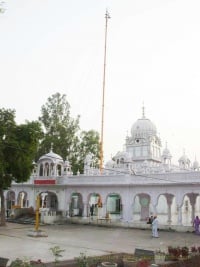
Bhai Kuram Singh, a Labana by caste, was a resident of village Lambian. He was a Sikh during the times of Guru Arjun and Guru Har Rai. Bhai Kuram came to Amritsar to have a glimpse of Guru Arjan. During his visit, mangoes were in season. Many visitors were coming to attend the darbar of the now famous Sikh Guru, the great Guru Arjan. The place was heaving with devotees. Many followers were presenting their gifts and offerings to the Guru. Followers from Kabul had brought with them large sumptuous ripe mangoes. In those days Kabul was famous for its mangoes.
Bhai Kuram Singh felt sorry that he had come from the land of mangoes but had not brought with him any mangoes. When the darbar concluded that night, the ripe mangoes were distributed as Parshad (blessed food). After receiving their parshad, the followers retired to their deras (sleeping quarters) for the night. Bhai Kuram Singh did not eat the mango given to him as parshad. Next day he got up in the morning, took bath and took the mango received as parshad and offered the same in darbar.
The great Guru Arjan called Bhai Kuram and said "This mango was given to you as parshad but you have offered the same here".
Bhai Kuram Singh very humbly bowed before the Guru and requested "Your Highness, I have come from the land of mangoes but have not brought any for offering to You, so I retained this for offering to you.
Guru Ji ordered him to eat the fruit and promised him that his offerings will be accepted by the Guru one day. .....More
PMA 5
Makhan Shah Labana.......by user:paapi
Makhan Shah Labana, was a Gursikh who played an important part in Sikh history. He is the Sikh who is called The discoverer of the ninth Nanak, Guru Tegh Bahadur. He was a person who displayed honesty, patience, humility, wisdom, intelligence and deep belief in God.
There is confusion among historians about the birth of Makhan Shah Labana. In some records, it is said that Baba ji's birth was on 23 Harh 1676 bikrami, which translates to 1619. Labana Itihas (historical records) of Giani Gurnam Singh says the birth was in 1703 bikrami which translates to 1647. But according to their siblings, the former date is said to be correct.
Like the date of birth, there is also much confusions about the place of birth. Some historians says that he was born at Tanda in Jammu and Kashmir. "Twarikh Guru Khalsa" of Gian Gingh says that Baba ji was born at Tanda in Muzzafrabad. This is linked to the visit by Guru Hargobind, the sixth Sikh Guru in 1626. But Colonel Gurbachan Singh in his book Makhan Shah Labana proved that wrong and after much searching, discovered that there was no village called Tanda in Muzaffranagar.
Mostly scholars like Sukha Singh, Macauliffe and G.S Chabbra says that Baba Makhan Shah was native of Kathiawad, Gujrat, India. There are so many Labanas in Kathiawad till today and they call themselves Lohana. Labana is also derived from Lohana. So due to businessmen/trader it is said that Baba ji was born in kathiawad, Gujrat. Scholars like Teja Singh, Ganda Singh and Sewa Dass says that he was a Masand of that area but there is no evidence to support this. Also it is thought that a trader can't do two jobs (ie: trading and preaching) at same time as it is recognised that he had to travel frequently in connection with his work. .....More
Proposed Women Article
PWA 1
Suggested by user:paapi. Done, see Template:AOW108
Mata Tripta was Guru Nanak's mother. The history of Sikh women has to start with her. She was the person who brought Guru Nanak, the founder of the Sikh religion into the world. In the annals of world history, the greatness of Mata Tripta, deserves to be celebrated for bringing to the world a soul who offered much spiritual and moral guidance and a solid and creditable foundation for a new world religion.
Mata Tripta and her husband Mehta Kalu lived in Talwandi, Punjab, which is now part of Pakistan. Weary saints and 'fakirs' would take rest here, and Mata Tripta would welcomed and serve all these passers-by. Their dedication for service of others was finally rewarded when Nanak was born in 1469. Thus, Mata Tripta was blessed with the honour of giving birth to God's messenger, Guru Nanak, whose mission was to redeem mankind.
No poet has ever been able to convey the ethereal beauty attained by Mata Tripta when she was expecting Nanak. Of the many prophets that have visited the earth, many of their mothers were unable to celebrate in the joy of rearing such wondrous offspring. For example; in Hinduism, Mata Devaki, the mother of Krishan Ji, was unable to fulfil her maternal role as she languished in jail. She yearned for her child, and he too missed the love of his mother. In Christianity, Mary, the mother of Jesus, endured disbelief and prejudice, as a result of the 'immaculate conception' and 'virgin birth' of Jesus. Buddha's mother died on the day of his birth, and he was reared by his mother's sister. Trishula, the mother of Mahavir, was constantly tormented by nightmares before his birth. .....More
PWA 2
PWA 3
Proposed Bani Article
PBA 1
Suggested by user:thegreateditor 09 July 2007 2:26PM
Zafarnama means the Notification of Victory and is the name given to the letter sent by the tenth Sikh Guru, Guru Gobind Singh in 1705 to the Emperor of India, Aurangzeb. The letter is written in exquisite Persian verse. In this letter, Guru Ji reminds Aurangzeb how he and his henchmen had broken their oaths taken on the holy Koran.
Despite this deception, this treacherous leader could not harm the Guru. Guru Ji states in this letter that in spite of his several sufferings, he had won a moral victory over the crafty Mughal who had broken all his vows and had resorted to underhand behaviour. Despite sending a huge army to capture or kill the Guru, the Mughal forces did not succeed in their mission.
The letter reads like a reprimand by a superior personality on a higher plane to a cruel and distorted inhuman being on a lower and pitiful plane. Guru Ji in the 111 verses of this notice rebuke Aurangzeb for his weaknesses as a human being and for excesses as a leader. Guru Ji confirms his confidence and his unflinching faith in the Almighty even after suffering extreme personal loss.
Of the 111 verses, the maximum numbers of 34 verses are to praise God; 32 deal with Aurangzeb’s invitation for the Guru to meet him and Guru's refusal to meet the Emperor - instead Guruji asks Aurangzeb to visit the Guru; 24 verses detail the events in the Battle of Chamkaur, which took place on 21 and 22 December 1704; 15 verses reprove Aurangzeb for breaking promise given by him and by his agents to the Guru; In verses 78 and 79, the Master had also warned Aurangzeb about the resolve of the Khalsa not to rest till his evil empire is destroyed; amazingly 6 verses actually praise Aurangzeb. .....More
PBA 2
Suggested by Lucky 09 July 2007 2:26PM
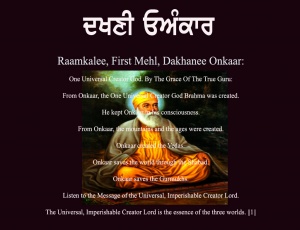
Oankar is composed in the form of an acrostic, each stanza beginning with one of the letters of the script meant for writing Sanskrit. Some of the sounds of Sanskrit do not exist in the language used by Guru Nanak. In such cases, prevalent equivalent sounds are used to represent the letters of the old script. For example, 'j' is used for 'y' and 'b' for 'v'. Oankar opens with verses in praise of God who is remembered as the creator of all that exists; of time with all its different cycles; and of the entire universe. Then follows the verse of rahau (pause) indicating the central theme of the bani : 0 Pandit, why are you involved in the writing of such idle hieroglyphics - write the name of God alone.
After this begins the acrostic form. The emphasis is on ethical and spiritual teaching. Men whose deeds fall short of their professions have been called moving corpses, i.e. corpses which only breathe. They are dead, spiritually. But even those so degraded have a chance of saving themselves if only they would make a total surrender to the "will of God" - Hukam. If such a person devotes himself to Naam, his mind would be cleansed of worldly temptations and cravings. The grace of the Guru will be a decisive factor in this process of spiritual regeneration. Temptation is the cause of suffering and sinfulness. Only those guided by the Guru's wisdom overcome it. No rituals can be of any help, nor any intellectual or scholarly accomplishment. Renunciation of the world and ascetic practices are of little avail. The real Pandit or wise man is he who follows the path shown by the Guru and remains united with God while performing his worldly duty.... .....More
Proposed Event Article
PEA 1
Proposed Other Articles
POA
Sikhism and the Environment - suggested by User:Mutia - see Template:AOW130
"The Lord infused His Light into the dust, and created the world, the universe. The sky, the earth, the trees, and the water - all are the Creation of the Lord. ||1||" SGGS page 723
The Sikh scripture called the Guru Granth Sahib, declares that the purpose of human beings is to achieve a blissful state and to be in harmony with the earth and all of God's creation. It seems, however, that humans have drifted away from that ideal. For today, the earth is today saturated with problems. It is agonizing over the fate of its inhabitants and their future! It is in peril as never before. Its lakes and rivers are being choked, killing its marine life. Its forests are being denuded. A smoky haze envelops the cities of the world. Human beings are exploiting fellow human beings.
The Sikh Gurus showed the world the way to live in harmony with the environment and all their constructions adhered to this principle. Guru Har Rai, the seventh Sikh Guru developed Kiratpur Sahib as a town of parks and gardens. Located on the banks of tributary of the Sutlej, he planted flowers and fruit bearing trees all over the area. This created a salubrious environment, attracting beautiful birds to the town and turning it into an idyllic place to live in. .....More
